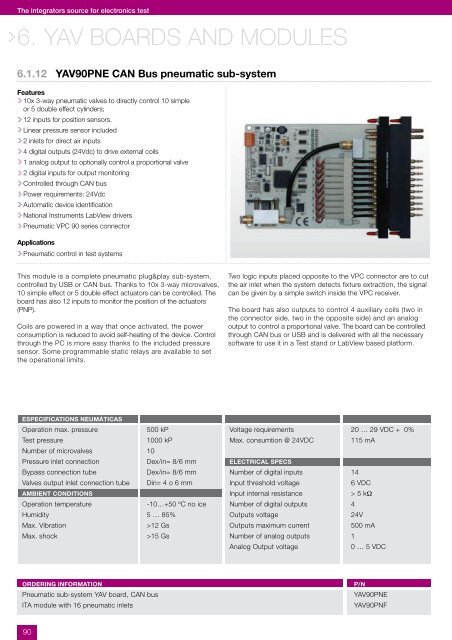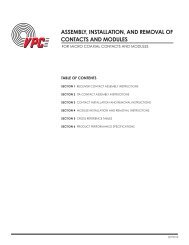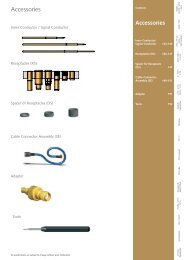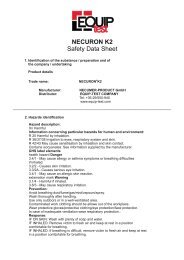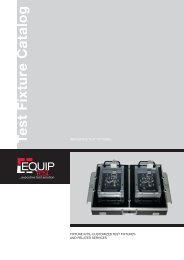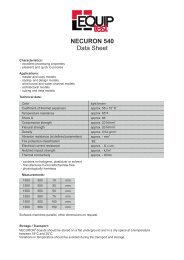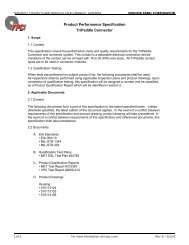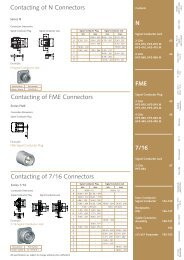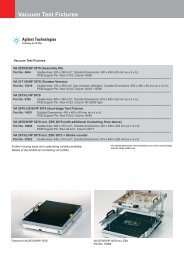YAV90PNE CAN Bus pneumatic sub-system Datasheet - Equip-Test
YAV90PNE CAN Bus pneumatic sub-system Datasheet - Equip-Test
YAV90PNE CAN Bus pneumatic sub-system Datasheet - Equip-Test
Create successful ePaper yourself
Turn your PDF publications into a flip-book with our unique Google optimized e-Paper software.
The integrators source for electronics test<br />
6. YAV BOARDS AND MODULES<br />
6.1.12 <strong>YAV90PNE</strong> <strong>CAN</strong> <strong>Bus</strong> <strong>pneumatic</strong> <strong>sub</strong>-<strong>system</strong><br />
Features<br />
10x 3-way <strong>pneumatic</strong> valves to directly control 10 simple<br />
or 5 double effect cylinders;<br />
12 inputs for position sensors.<br />
Linear pressure sensor included<br />
2 inlets for direct air inputs<br />
4 digital outputs (24Vdc) to drive external coils<br />
1 analog output to optionally control a proportional valve<br />
2 digital inputs for output monitoring<br />
Controlled through <strong>CAN</strong> bus<br />
Power requirements: 24Vdc<br />
Automatic device identification<br />
National Instruments LabView drivers<br />
Pneumatic VPC 90 series connector<br />
Applications<br />
Pneumatic control in test <strong>system</strong>s<br />
This module is a complete <strong>pneumatic</strong> plug&play <strong>sub</strong>-<strong>system</strong>,<br />
controlled by USB or <strong>CAN</strong> bus. Thanks to 10x 3-way microvalves,<br />
10 simple effect or 5 double effect actuators can be controlled. The<br />
board has also 12 inputs to monitor the position of the actuators<br />
(PNP).<br />
Coils are powered in a way that once activated, the power<br />
consumption is reduced to avoid self-heating of the device. Control<br />
through the PC is more easy thanks to the included pressure<br />
sensor. Some programmable static relays are available to set<br />
the operational limits.<br />
Two logic inputs placed opposite to the VPC connector are to cut<br />
the air inlet when the <strong>system</strong> detects fixture extraction, the signal<br />
can be given by a simple switch inside the VPC receiver.<br />
The board has also outputs to control 4 auxiliary coils (two in<br />
the connector side, two in the opposite side) and an analog<br />
output to control a proportional valve. The board can be controlled<br />
through <strong>CAN</strong> bus or USB and is delivered with all the necessary<br />
software to use it in a <strong>Test</strong> stand or LabView based platform.<br />
ESPECIFICATIONS NEUMÁTICAS<br />
Operation max. pressure 500 kP Voltage requirements 20 … 29 VDC + 0%<br />
<strong>Test</strong> pressure 1000 kP Max. consumtion @ 24VDC 115 mA<br />
Number of microvalves 10<br />
Pressure inlet connection Dex/in= 8/6 mm ELECTRICAL SPECS<br />
Bypass connection tube Dex/in= 8/6 mm Number of digital inputs 14<br />
Valves output inlet connection tube Din= 4 o 6 mm Input threshold voltage 6 VDC<br />
AMBIENT CONDITIONS Input internal resistance > 5 kΩ<br />
Operation temperature -10…+50 ºC no ice Number of digital outputs 4<br />
Humidity 5 … 85% Outputs voltage 24V<br />
Max. Vibration >12 Gs Outputs maximum current 500 mA<br />
Max. shock >15 Gs Number of analog outputs 1<br />
Analog Output voltage<br />
0 … 5 VDC<br />
ORDERING INFORMATION<br />
Pneumatic <strong>sub</strong>-<strong>system</strong> YAV board, <strong>CAN</strong> bus<br />
ITA module with 16 <strong>pneumatic</strong> inlets<br />
P/N<br />
<strong>YAV90PNE</strong><br />
YAV90PNF<br />
90
www.6tl.es<br />
Schematic<br />
91


